
Navajo rug
Encyclopedia
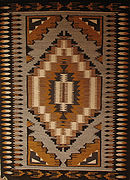
Textile
A textile or cloth is a flexible woven material consisting of a network of natural or artificial fibres often referred to as thread or yarn. Yarn is produced by spinning raw fibres of wool, flax, cotton, or other material to produce long strands...
s produced by Navajo people
Navajo people
The Navajo of the Southwestern United States are the largest single federally recognized tribe of the United States of America. The Navajo Nation has 300,048 enrolled tribal members. The Navajo Nation constitutes an independent governmental body which manages the Navajo Indian reservation in the...
of the Four Corners area of the United States
United States
The United States of America is a federal constitutional republic comprising fifty states and a federal district...
. Navajo textiles are highly regarded and have been sought after as trade items for over 150 years. Commercial production of handwoven blanket
Blanket
A blanket is a type of bedding, generally speaking, a large piece of cloth, intended to keep the user warm, especially while sleeping. Blankets are distinguished from sheets by their thickness and purpose; the thickest sheet is still thinner than the lightest blanket. Blankets are generally used...
s and rug
Rug making
Rug making is an ancient craft, and covers a variety of techniques.-Braided:Braided rugs are made by using three or more strips of fabric, usually wool, folding the raw edges to the middle and braiding them together. For an oval rug the center braid should be one inch longer than the width-length...
s has been an important element of the Navajo economy. As one expert expresses it, "Classic Navajo serapes at their finest equal the delicacy and sophistication of any pre-mechanical loom
Loom
A loom is a device used to weave cloth. The basic purpose of any loom is to hold the warp threads under tension to facilitate the interweaving of the weft threads...
-woven textile in the world."
Navajo textiles were originally utilitarian blankets for use as cloaks, dresses, saddle blanket
Saddle blanket
The terms saddle blanket, saddle pad and saddle cloth refer to blankets, pads or fabrics inserted under a saddle. These are usually used to absorb sweat, cushion the saddle, and protect the horse's back. Saddle blankets have been used for many centuries with all types of saddles...
s, and similar purposes. Toward the end of the 19th century, weavers began to make rugs for tourism and export. Typical Navajo textiles have strong geometric
Geometry
Geometry arose as the field of knowledge dealing with spatial relationships. Geometry was one of the two fields of pre-modern mathematics, the other being the study of numbers ....
patterns. They are a flat tapestry
Tapestry
Tapestry is a form of textile art, traditionally woven on a vertical loom, however it can also be woven on a floor loom as well. It is composed of two sets of interlaced threads, those running parallel to the length and those parallel to the width ; the warp threads are set up under tension on a...
-woven
Weaving
Weaving is a method of fabric production in which two distinct sets of yarns or threads are interlaced at right angles to form a fabric or cloth. The other methods are knitting, lace making and felting. The longitudinal threads are called the warp and the lateral threads are the weft or filling...
textile produced in a fashion similar to kilim
Kilim
Kilims are flat tapestry-woven carpets or rugs produced from the Balkans to Pakistan. Kilims can be purely decorative or can function as prayer rugs. Recently-made kilims are popular floor-coverings in Western households.-Etymology:...
s of Eastern Europe
Eastern Europe
Eastern Europe is the eastern part of Europe. The term has widely disparate geopolitical, geographical, cultural and socioeconomic readings, which makes it highly context-dependent and even volatile, and there are "almost as many definitions of Eastern Europe as there are scholars of the region"...
and Western Asia, but with some notable differences. In Navajo weaving, the slit weave technique common in kilims is not used, and the warp is one continuous length of yarn, not extending beyond the weaving as fringe. Traders from the late 19th and early 20th century encouraged adoption of some kilim motifs into Navajo designs.
Purpose
The original function of Navajo weaving was to produce clothing: "shoulder robes, rectangular panel or wrap-around-dresses, semi-tailored shirts, breechclothBreechcloth
A breechcloth, or breechclout, is a form of loincloth consisting in a strip of material – usually a narrow rectangle – passed between the thighs and held up in front and behind by a belt or string. Often, the flaps hang down in front and back.- Native Americans :In most Native American...
s, and a variety of belts, sashes, hair ties, and garters." The Navajo did not produce rugs until export markets expanded at the end of the 19th century, and their textiles served no specific religious or ceremonial function.
History
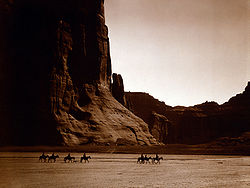
Pueblo influence
The Navajo may have learned to weave from their Pueblo Indian neighbors when they moved into the Four Corners region during the period from 1300 to 1500. Some experts contend that the Navajo were not weavers until after the 17th century. Navajo obtained cottonCotton
Cotton is a soft, fluffy staple fiber that grows in a boll, or protective capsule, around the seeds of cotton plants of the genus Gossypium. The fiber is almost pure cellulose. The botanical purpose of cotton fiber is to aid in seed dispersal....
through local trade routes before the arrival of the Spanish, after which time they began to use wool
Wool
Wool is the textile fiber obtained from sheep and certain other animals, including cashmere from goats, mohair from goats, qiviut from muskoxen, vicuña, alpaca, camel from animals in the camel family, and angora from rabbits....
. The Pueblo and Navajo were not generally on friendly terms due to frequent Navajo raids on Pueblo settlements, yet many Pueblo sought refuge with their Navajo neighbors in the late 17th century to evade the conquistador
Conquistador
Conquistadors were Spanish soldiers, explorers, and adventurers who brought much of the Americas under the control of Spain in the 15th to 16th centuries, following Europe's discovery of the New World by Christopher Columbus in 1492...
s in the aftermath of the Pueblo Revolt
Pueblo Revolt
The Pueblo Revolt of 1680, or Popé's Rebellion, was an uprising of several pueblos of the Pueblo people against Spanish colonization of the Americas in the province of Santa Fe de Nuevo México.-Background:...
. This social interchange is the probable origin of the distinctive Navajo weaving tradition. Spanish records show that Navajo people began to herd sheep and weave wool blankets from that time onward.
The extent of Pueblo influence on Navajo weaving is uncertain. As Wolfgang Haberland notes, "Prehistoric Puebloan textiles were much more elaborate than historic ones, as can be seen in the few remnants recovered archaeologically and in costumed figures in pre-contact kiva murals." Haberland suggests that the absence of surviving colonial-era Pueblo textile examples make it impossible to do more than conjecture about whether the creative origins of Navajo weaving arose from Navajo culture or were borrowed from the neighboring people.
Early records
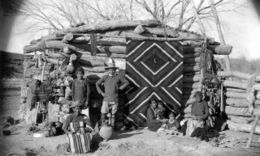
Canyon de Chelly National Monument
Canyon de Chelly National Monument was established on April 1, 1931 as a unit of the National Park Service. It is located in northeastern Arizona within the boundaries of the Navajo Nation...
, Arizona
Arizona
Arizona ; is a state located in the southwestern region of the United States. It is also part of the western United States and the mountain west. The capital and largest city is Phoenix...
. In 1804, a group of Navajo were shot and killed there, where they were seeking refuge from Spanish soldiers. For a hundred years the cave remained untouched due to Navajo taboos until a local trader named Sam Day entered it and retrieved the textiles. Day separated the collection and sold it to various museums. The majority of Massacre Cave blankets feature plain stripes, yet some exhibit the terraces and diamonds characteristic of later Navajo weaving.
Wider commerce
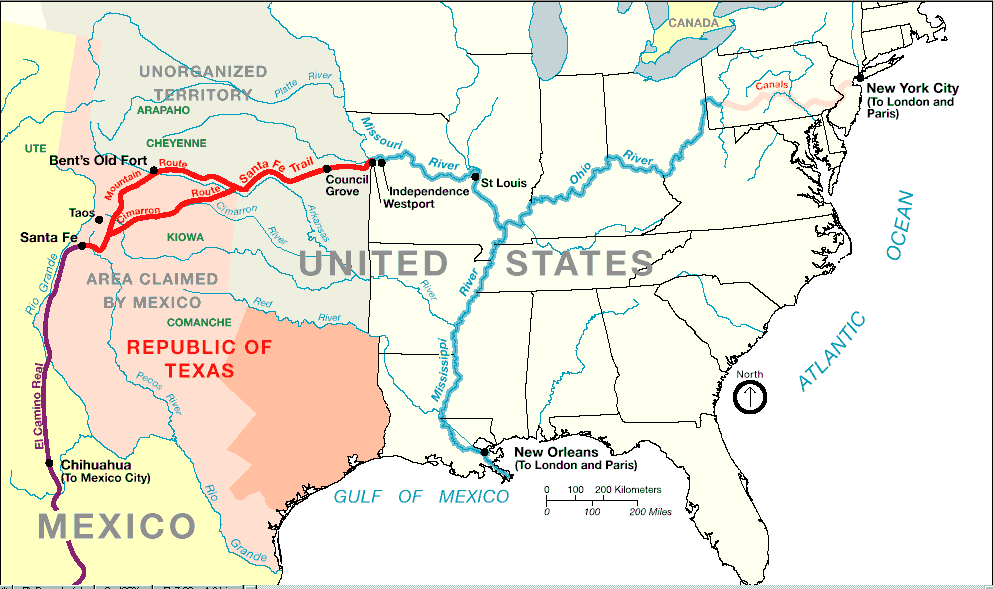
Santa Fe Trail
The Santa Fe Trail was a 19th-century transportation route through central North America that connected Missouri with Santa Fe, New Mexico. Pioneered in 1822 by William Becknell, it served as a vital commercial and military highway until the introduction of the railroad to Santa Fe in 1880...
opened in 1822, and greater numbers of examples survive. Until 1880, all such textiles were blankets as opposed to rugs. In 1850, these highly prized trade items sold for $50 in gold, a huge sum at that time.
Railroad service reached Navajo lands in the early 1880s and resulted in considerable expansion of the market for Navajo woven goods. According to Kathy M'Closkey of the University of Windsor
University of Windsor
The University of Windsor is a public comprehensive and research university in Windsor, Ontario, Canada. It is Canada's southernmost university. It has a student population of approximately 15,000 full-time and part-time undergraduate students and over 1000 graduate students...
in Ontario
Ontario
Ontario is a province of Canada, located in east-central Canada. It is Canada's most populous province and second largest in total area. It is home to the nation's most populous city, Toronto, and the nation's capital, Ottawa....
, Canada
Canada
Canada is a North American country consisting of ten provinces and three territories. Located in the northern part of the continent, it extends from the Atlantic Ocean in the east to the Pacific Ocean in the west, and northward into the Arctic Ocean...
, "wool production more than doubled between 1890 and 1910, yet textile production escalated more than 800%". Purchases of manufactured yarn compensated for the deficit in wool production. Federal government reports affirmed that this weaving, which was performed almost exclusively by women, was the most profitable Navajo industry during that era. Quality declined in some regards as the weavers attempted to keep up with demand. However in today society an average price of a rug goes for about $800.00.
Several European-American merchants influenced Navajo weaving during the next decades. The first to advertise Navajo textiles in a catalog was C. N. Cotton in 1894. Cotton encouraged professional production and marketing among his peers and the weavers whose work they handled. Another trader named J. B. Moore, who settled in the Chuska Mountains
Chuska mountains
The Chuska Mountains are an elongate range on the Colorado Plateau and within the Navajo Nation. The range is about 80 by 15 km , and it trends north-northwest and is crossed by the state line between Arizona and New Mexico. The highlands are a dissected plateau, with an average elevation of...
in 1897 attempted to improve the quality of textiles he traded. He attempted to regulate the cleaning and dyeing
Dyeing
Dyeing is the process of adding color to textile products like fibers, yarns, and fabrics. Dyeing is normally done in a special solution containing dyes and particular chemical material. After dyeing, dye molecules have uncut Chemical bond with fiber molecules. The temperature and time controlling...
process of artisans who did business with him, and shipped wool intended for higher grade weaving outside the region for factory cleaning. He limited the range of dyes in textiles he traded and refused to deal fabric that had included certain commercially produced yarns. Moore's catalogs identified individual textile pieces rather than illustrating representative styles. He appears to have been instrumental in introducing new motifs to Navajo weaving. Carpets from the Caucasus
Caucasus
The Caucasus, also Caucas or Caucasia , is a geopolitical region at the border of Europe and Asia, and situated between the Black and the Caspian sea...
region were popular among Anglo-America
Anglo-America
Anglo-America is a region in the Americas in which English is a main language, or one which has significant British historical, ethnic, linguistic, and cultural links...
ns at that time. Both the Navajo and the Caucasus weavers worked under similar conditions and in similar styles, so it was relatively simple for them to incorporate Caucasus patterns such as an octagonal motif known as a gul.
Traders encouraged the locals to weave blankets and rugs into distinct styles. They included "Two Gray Hills" (predominantly black and white, with traditional patterns), "Teec Nos Pos" (colorful, with very extensive patterns), "Ganado" (founded by Don Lorenzo Hubbell
Don Lorenzo Hubbell
Don Lorenzo Hubbell was a 19th century trader instrumental in promoting the sale of Navajo art. He was also sheriff of Apache County, Arizona, a member of the Arizona Territorial Legislature, and after statehood a member of the Arizona Senate...
), red dominated patterns with black and white, "Crystal" (founded by J. B. Moore), Oriental
Oriental rug
An authentic oriental rug is a handmade carpet that is either knotted with pile or woven without pile.By definition - Oriental rugs are rugs that come from the orient...
and Persian styles (almost always with natural dye
Natural dye
Natural dyes are dyes or colorants derived from plants, invertebrates, or minerals. The majority of natural dyes are vegetable dyes from plant sources – roots, berries, bark, leaves, and wood — and other organic sources such as fungi and lichens....
s), "Wide Ruins," "Chinle," banded geometric patterns, "Klagetoh", diamond type patterns, "Red Mesa
Mesa
A mesa or table mountain is an elevated area of land with a flat top and sides that are usually steep cliffs. It takes its name from its characteristic table-top shape....
" and bold diamond patterns. Many of these patterns exhibit a fourfold symmetry, which is thought by Professor Gary Witherspoon
Gary Witherspoon
Gary J. Witherspoon is Professor of American Indian studies at the University of Washington. His area of expertise is the Navajo language and Navajo culture....
to embody traditional ideas about harmony or Hozh.
Recent developments
Large numbers of Navajo continue to weave commercially. Contemporary weavers are more likely to learn the craft from a community collegeCommunity college
A community college is a type of educational institution. The term can have different meanings in different countries.-Australia:Community colleges carry on the tradition of adult education, which was established in Australia around mid 19th century when evening classes were held to help adults...
course, as opposed to family. A navajo woman struggles and sacrifices, but for some this is their only source of income. Contemporary Navajo textiles have suffered commercially from two sets of pressures: extensive investment in pre-1950 examples and price competition from foreign imitations. Modern Navajo rugs are indeed notable for their high prices.
Construction
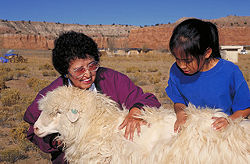
Wool and yarn
In the late 17th century, the Navajo acquired the IberiaIberian Peninsula
The Iberian Peninsula , sometimes called Iberia, is located in the extreme southwest of Europe and includes the modern-day sovereign states of Spain, Portugal and Andorra, as well as the British Overseas Territory of Gibraltar...
n Churra, a breed of sheep from Spanish explorers
Conquistador
Conquistadors were Spanish soldiers, explorers, and adventurers who brought much of the Americas under the control of Spain in the 15th to 16th centuries, following Europe's discovery of the New World by Christopher Columbus in 1492...
. These animals were developed in to a unique breed by the Navajo, today called the Navajo-Churro. These sheep were well-suited to the climate in Navajo lands, and that produced a useful long-staple wool. Hand-spun wool from these animals was the main source of yarn for Navajo blankets until the 1860s, when the United States government forced the Navajo people to relocate at Bosque Redondo and seized their livestock. The 1869 peace treaty that allowed the Navajo to return to their traditional lands included a $30,000 settlement to replace their livestock. The tribe purchased 14,000 sheep and 1,000 goats.
Mid-19th century Navajo rugs often used a three-ply yarn called Saxony, which refers to high-quality, naturally dyed, silky yarns. Red tones in Navajo rugs of this period come either from Saxony
Saxony
The Free State of Saxony is a landlocked state of Germany, contingent with Brandenburg, Saxony Anhalt, Thuringia, Bavaria, the Czech Republic and Poland. It is the tenth-largest German state in area, with of Germany's sixteen states....
or from a raveled cloth known in Spanish as bayeta, which was a woolen manufactured in England
England
England is a country that is part of the United Kingdom. It shares land borders with Scotland to the north and Wales to the west; the Irish Sea is to the north west, the Celtic Sea to the south west, with the North Sea to the east and the English Channel to the south separating it from continental...
. With the arrival of the railroad in the early 1880s, another machine-produced yarn came into use in Navajo weaving: a four-ply aniline dyed yarn known as Germantown because the yarn was manufactured in Pennsylvania
Pennsylvania
The Commonwealth of Pennsylvania is a U.S. state that is located in the Northeastern and Mid-Atlantic regions of the United States. The state borders Delaware and Maryland to the south, West Virginia to the southwest, Ohio to the west, New York and Ontario, Canada, to the north, and New Jersey to...
.
Among the locally produced yarns for Navajo textile, indiscriminate breeding from 1870-1890 caused a steady decline in wool quality. Increasing proportions of brittle kemp
Kemp (wool)
Kemp is generally a chalky-white, brittle, weak fibre which may be mixed with normal fibers in a sheep's wool fleece. Kemp fibres are often detached from the skin. This hair is not desirable in a fleece, as it does not accept dye, minimising both the quality and the value of the wool....
can be found in well-preserved examples from the period. In 1903, federal agents attempted to address the problem by introducing Rambouillet
Rambouillet (sheep)
The Rambouillet is also known as the Rambouillet Merino or the French Merino. The development of the Rambouillet breed started in 1786 when Louis XVI purchased over three hundred Spanish Merinos from his cousin, King Charles III of Spain...
rams into the breeding population. The Rambouillet is a French
France
The French Republic , The French Republic , The French Republic , (commonly known as France , is a unitary semi-presidential republic in Western Europe with several overseas territories and islands located on other continents and in the Indian, Pacific, and Atlantic oceans. Metropolitan France...
breed that produces good meat and heavy, fine-wool fleeces. The Rambouillet stock, were well adapted to the Southwestern climate, but their wool was less suitable to hand spinning. Short-stapled Rambouillet wool has a tight crimp, which makes hand spinning difficult. The higher lanolin
Lanolin
Lanolin , also called Adeps Lanae, wool wax or wool grease, is a yellow waxy substance secreted by the sebaceous glands of wool-bearing animals. Most lanolin used by humans comes from domestic sheep...
content of its wool necessitated significantly more scouring with scarce water before it could be dyed effectively. From 1920 to 1940, when Rambouillet bloodlines dominated the tribe's stock, Navajo rugs have a characteristicly curly wool and sometimes a knotted or lumpy appearance.
In 1935, the United States Department of the Interior
United States Department of the Interior
The United States Department of the Interior is the United States federal executive department of the U.S. government responsible for the management and conservation of most federal land and natural resources, and the administration of programs relating to Native Americans, Alaska Natives, Native...
created the Southwestern Range and Sheep Breeding Laboratory to address the problems Rambouillet stock had caused for the Navajo economy. Located at Fort Wingate, New Mexico, the program's aim was to develop a new sheep bloodline that simulated the wool characteristics of the 19th-century Navajo-Churro stock and would also supply adequate meat. The Fort Wingate researchers collected old Navajo-Churro stock from remote parts of the reservation and hired a weaver to test their experimental wool. Offspring of these experiments were distributed among the Navajo people. World War II
World War II
World War II, or the Second World War , was a global conflict lasting from 1939 to 1945, involving most of the world's nations—including all of the great powers—eventually forming two opposing military alliances: the Allies and the Axis...
interrupted the greater part of this effort when military work resumed at Fort Wingate.
Coloration
Prior to the mid-19th century, Navajo weaving coloration was mostly natural brown, white, and indigoIndigo
Indigo is a color named after the purple dye derived from the plant Indigofera tinctoria and related species. The color is placed on the electromagnetic spectrum between about 420 and 450 nm in wavelength, placing it between blue and violet...
. Indigo dye was obtained through trade and purchased in lumps.
By the middle of the century, the palette had expanded to include red, black, green, yellow, and gray which signifies different aspects of the earth as defined by different locations of the reservation. Navajo used indigo to obtain shades from pale blue to near black and mixed it with indigenous yellow dyes such as the rabbit brush plant to obtain bright green effects. Red was the most difficult dye to obtain locally. Early Navajo textiles use cochineal
Cochineal
The cochineal is a scale insect in the suborder Sternorrhyncha, from which the crimson-colour dye carmine is derived. A primarily sessile parasite native to tropical and subtropical South America and Mexico, this insect lives on cacti from the genus Opuntia, feeding on plant moisture and...
, an extract from a Mesoamerica
Mesoamerica
Mesoamerica is a region and culture area in the Americas, extending approximately from central Mexico to Belize, Guatemala, El Salvador, Honduras, Nicaragua, and Costa Rica, within which a number of pre-Columbian societies flourished before the Spanish colonization of the Americas in the 15th and...
n beetle, which often made a circuitous trade route through Spain and England on its way to the Navajo. Reds used in Navajo weaving tended to be raveled from imported textiles. The Navajo obtained black dye through piñon
Piñon
Piñon may refer to:* Pinyon pine * Pinon Airplant, Tillandsia excelsa-Places:* Piñon, Arizona, United States* Piñon, New Mexico, United States* Pinon, Aisne, a commune of the Aisne department in France...
pitch and ashes.
After railroad service began in the early 1880s, aniline dyes became available in bright shades of red, orange, green, purple, and yellow. Gaudy "eyedazzler" weaves dominated the final years of the 19th century. Navajo weaving aesthetics underwent rapid change as artisans experimented with the new palette and a new clientele entered the region whose tastes differed from earlier purchasers. During the later years of the 19th century, the Navajo continued to produce earlier styles for traditional customers while they adopted new techniques for a second market.
Weaving
Traditional Navajo weaving used upright looms with no moving parts. Support poles were traditionally constructed of wood; steel pipe is more common today. The artisan sits on the floor during weaving and wraps the finished portion of fabric underneath the loom as it grows. The average weaver takes anywhere from 2 months to many years to finish a single rug. The size greatly determines the amount of time spent weaving a rug. The ratio of weftWeft
In weaving, weft or woof is the yarn which is drawn through the warp yarns to create cloth. In North America, it is sometimes referred to as the "fill" or the "filling yarn"....
to warp
Warp (weaving)
In weaving cloth, the warp is the set of lengthwise yarns that are held in tension on a frame or loom. The yarn that is inserted over-and-under the warp threads is called the weft, woof, or filler. Each individual warp thread in a fabric is called a warp end or end. Warp means "that which is thrown...
threads had a fine count before the Bosque Redondo internment and declined in the following decades, then rose somewhat to a midrange ratio of five to one for the period 1920-1940. 19th-century warps were colored handspun wool or cotton string, then switched to white handspun wool in the early decades of the 20th century.
Cultural perspectives
Weaving plays a role in the creation myth of Navajo cosmologyCosmology
Cosmology is the discipline that deals with the nature of the Universe as a whole. Cosmologists seek to understand the origin, evolution, structure, and ultimate fate of the Universe at large, as well as the natural laws that keep it in order...
, which articulates social relationships and continues to play a role in Navajo culture. According to one aspect of this tradition, a spiritual being called "Spider Woman" instructed the women of the Navajo how to build the first loom from exotic materials including sky, earth, sunrays, rock crystal, and sheet lightning
Lightning
Lightning is an atmospheric electrostatic discharge accompanied by thunder, which typically occurs during thunderstorms, and sometimes during volcanic eruptions or dust storms...
. Then "Spider Woman" taught the Navajo how to weave on it.
Use of traditional motifs sometimes leads to the mistaken notion that these textiles serve a purpose in Navajo religion. Actually these items have no use as prayer rugs or any other ceremonial function, and controversy has existed among the Navajo about the appropriateness of including religious symbolism in items designed for commercial sale. The financial success of purported ceremonial rugs led to their continued production.
Critical study
Until recently, anthropologists have dominated the study of Navajo textiles. Most historic examples of these works belong to ethnologicalEthnology
Ethnology is the branch of anthropology that compares and analyzes the origins, distribution, technology, religion, language, and social structure of the ethnic, racial, and/or national divisions of humanity.-Scientific discipline:Compared to ethnography, the study of single groups through direct...
collections rather than fine art
Fine art
Fine art or the fine arts encompass art forms developed primarily for aesthetics and/or concept rather than practical application. Art is often a synonym for fine art, as employed in the term "art gallery"....
collections, which mean items have been exhibited and analyzed with an eye toward normative or average works rather than emphasizing technical or artistic excellence. These priorities have artificially inflated the market value for items of inferior craftsmanship. In general, this tendency has affected most non-European art to some degree.
Other factors that have hindered art criticism of Navajo textiles include the common distinction between fine art and applied art
Applied art
Applied art is the application of design and aesthetics to objects of function and everyday use. Whereas fine arts serve as intellectual stimulation to the viewer or academic sensibilities, the applied arts incorporate design and creative ideals to objects of utility, such as a cup, magazine or...
and the scholarly theory among some archaeologists and art historians
Art history
Art history has historically been understood as the academic study of objects of art in their historical development and stylistic contexts, i.e. genre, design, format, and style...
that pure artistic expression cannot exist among non-literate peoples.
External links and further reading
- Weaving in Beauty, how to identify types of Navajo textiles, weaving classes, articles
- Navajo Nation Arts & Crafts Enterprise
- History of the Navajo Rug, by Navajo Rug Repair Co.
- TOWARDS AN UNDERSTANDING OF NAVAJO AESTHETICS Kathy M’Closkey
- Navajo Weaving at the Arizona State Museum: 19th Century Blankets, 20th Century Rugsf, 21st Century Views. A good illustrated history, with comments from Navajo weavers and museum curators.
- Navajo chief's blankets: three phases, by Douglas Deihl, appraiser
- Links to articles on Navajo rugs

